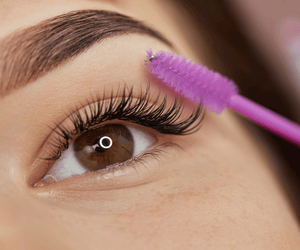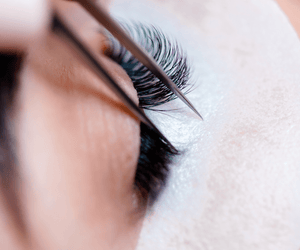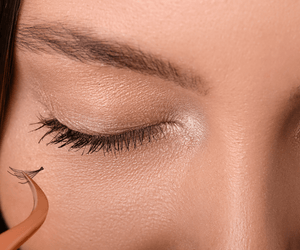Curious as to why your eyes turn red after lash extensions? Having red or bloodshot eyes after extensions is a common side effect.
The post-extension redness is usually a sign of mild irritation from the adhesive fumes or from having undereye pads pull on your lower lashes. It’s usually quick to resolve on its own, without the need for treatment.
In this guide, we’ll dive into all the reasons why lash extensions can turn your eyes red, how to identify a more severe or unusual reaction, and provide a few lash safety tips to keep your eyes safe in the future.
Table of Contents
Common Causes of Red Eyes After Lash Extensions
Irritation from Adhesive Fumes
Lash extension adhesives are made of cyanoacrylate-based glues that cure when their volatile components, like formaldehyde, evaporate. The evaporating fumes get in the eyes and cause irritation, either during the application or in the hours following.
This is the most common reason for red eyes after extensions, usually along with a slight stinging sensation and tearing. This type of irritation is called keratoconjunctivitis. It’s usually mild and disappears within a day.
Allergy
Allergies to the lash adhesive may also cause red eyes. It can be tough to tell the difference between an allergy and irritation, but itching, swelling, and flakiness or patchy skin around the eyelids are good hints. More severe allergic reactions may also include more significant swelling or trouble breathing.
The risk of allergic reaction actually increases with repeated exposure, so patch testing before your first extension application may not be useful.
Poor Pad Placement
During the lash extension application, the technician places pads over the lower lashes to keep them out of the way. If the pad is applied too closely, it can actually come in contact and irritate or even scratch the eye, resulting in more long-lasting redness and discomfort concentrated near the area of contact.
Another common technician error is placing the pad so it pulls downward on the lower lashes, exposing part of the eye to air and adhesive fumes during the application.
Improper Lash Placement
Lash extensions should always be placed at least 0.5 mm away from the lash line. Otherwise, they can touch your lash line, resulting in mechanical irritation and redness.
Dry Eyes
If your lash extensions impede your blinking, your eyes may dry out, which can lead to redness as well as discomfort.
Infection
Lash extensions can slightly increase your risk of developing an eye or skin infection, especially if your eye has been scratched by poor technique from your lash stylist or if your aftercare has been lacking. In the worst case, it can lead to symptoms like significant pain, swelling, vision trouble, and discharge.
Demodex mites, in particular, can colonize the lashes if aftercare is poor. They can cause blepharitis, a type of inflammation that can be confused with an allergic reaction.
Is Redness Ever “Normal”?
A little redness, discomfort, or teary eyes after a lash extension appointment is normal, but if you experience more than that, you should assume something went wrong. Seek medical care right away if you experience lasting redness, pain, significant swelling, discharge from the eyes/surrounding skin, or changes to your vision.
What You Can Do Right Now (Safe, At-Home Steps)?
You’re home from your lash appointment, and your eyes are slightly red or irritated. What should you do? First of all, resist the urge to rub or touch your eyes. If you typically wear contact lenses, avoid them for a day.
The redness may go away on its own with regular lash extensions aftercare. You can also use simple, lubricating eye drops to counter dryness or a cold compress to alleviate any stinging or discomfort.
If the redness and irritation aren’t going away or you’re also experiencing other symptoms, seek additional help. For example, if you’re worried about improper lash placement or ongoing irritation from the lashes or adhesive, go back to your lash technician to have the lashes removed.
For signs of a mild allergic reaction, like itchiness, swelling, or flaky skin around the eyes, use over-the-counter allergy treatments. You may also need to have your eyelash extensions removed. If the allergy is more severe, speak to a doctor.
You might be tempted to use redness-reducing eye drops, but think twice. They're only a temporary cosmetic solution. These eye drops don't help with healing, as they actually restrict the blood vessels in the eye.
When to Seek Professional Care?
If you experience any of the following symptoms, in addition to red eyes, seek medical care immediately:
- Significant pain
- Changes to your vision, like blurriness or light sensitivity
- Fever
- Trouble breathing
- Discharge or pus
- Significant swelling
- Redness or other symptoms that don’t subside within a few days.
Prevention & Aftercare for Future Appointments
Once you identify what caused your eyes to turn red, you can prevent it in the future.
First of all, consider whether getting lash extensions again is even safe for you. If you had an allergic reaction, it's probably the end of your relationship with professional extensions.
If you decide to get extensions again, choose a certified and insured lash technician with a lot of experience. Before booking, ask your tech about their practices for preventing irritation and inquire about the type of adhesive they use. They may suggest a patch test, use hypoallergenic adhesives, or have some sort of fume-mitigating tools or products.
Once at home, keep your lashes clean — use a lash-safe shampoo to remove oil and dead skin buildup to prevent demodex infestations or infections. Avoid using any oily products around the eyes.
Consider gentle lash extension alternatives. Lilac St lashes can be a nice option if you're prone to irritation (but not if you're allergic). They go on with a milder, skin-safe adhesive that sets quickly and emits fewer volatile components. The process to apply them is also much quicker, but the lashes can stay put for several days in a row.
Bottom Line
If your eyes are a little bloodshot or watery after your lash extension appointment, you don’t need to worry — it’s quite normal, and it’ll probably fade very soon.
The presence of other symptoms or significant discomfort should raise red flags, though. Consider whether you need the extensions removed or to receive additional medical care, especially if you suspect an allergic reaction, corneal abrasion, or an infection.








